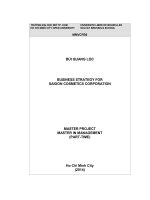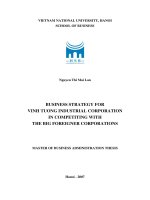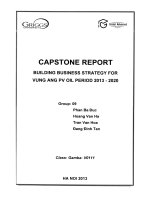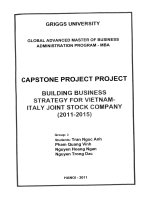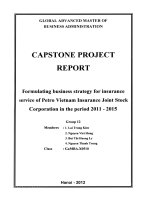Recommending business strategy for fico cement corporation in period 2011 - 2020
Bạn đang xem bản rút gọn của tài liệu. Xem và tải ngay bản đầy đủ của tài liệu tại đây (838.47 KB, 58 trang )
GRIGGS UNIVERSITY
GLOBAL ADVANCED MASTER OF BUSINESS ADMINISTRATION
PROGRAM
CAPSTONE PROJECT REPORT
RECOMMENDING BUSINESS STRATEGY
FOR FICO CEMENT CORPORATION
IN PERIOD 2011-2020
Class : GaMBA01.C0110
Group number : 07
1. TRUONG ANH TUAN
2. DO THI BICH DAO
3. NGUYEN THIEU LAM
4. HOANG TUYET MAI
5. NGUYEN PHUONG TAN
HO CHI MINH CITY – 2011
MGMT 689 – Strategic Management
2
COMMITMENT
Group 7 consisting of five members commit that the thesis in the Global
Advanced Master Of Business Administration Program - Griggs University is the
study carried out by the group.
All the theories and data in our thesis are conducted by our group members
and partly referenced from textbooks, course books, other reference materials in
Vietnamese and English as well as magazines, the Internet, etc. The real data is
directly collected from FICO Tay Ninh Cement Company.
Based the aforementioned data source and the approved outlines, our team
complete this thesis. Based on theoretical background, intuition and experience of
group members, the business strategies for FICO are. Also, through this thesis the
group members have accumulated some valuable experience for the establishment
of a practical strategy for a company.
Group representative
Truong Anh Tuan
MGMT 689 – Strategic Management
3
ACKNOWLEDGEMENT
After nearly two years of studying at the global advanced master of business
administration program - Griggs University, group 7 would like to express our deep
gratitude to the MBA Program - Griggs University for creating the most favorable
conditions for us during the studying process. Sincerely we show our gratitude to
the teachers who supply dedicated instructions, transfer knowledge and update
information to help us to apply the knowledge and skills we have learned to our real
work. We are also grateful to the supervisors for supporting us to complete the
thesis.
Our group would like to show our deep gratitude to the teaching assistants
for supporting us. We are grateful to the Board of Directors of FICO Tay Ninh
Cement Company for providing us with useful data and information to complete
this thesis.
Finally we sincerely thank the board of management of the company where
we are working and all the group members for creating conditions for us to
complete the course .in terms of time and cost.
Please accept our sincere and deep gratitude.
Group 7 GaMBA01.C0110
MGMT 689 – Strategic Management
4
TABLE OF CONTENTS
LIST OF TABLES 6
LIST OF FIGURES 6
FOREWORD 7
CHAPTER 1: LITERATURE REVIEW 8
1.1. The concept of business strategy planning 8
1.2.The strategic planning process 8
1.2.1. Strategy formulation phase 8
1.2.2. Strategy implementation phase 8
1.2.3. Strategy evaluation phase 8
1.3. Classification / strategic levels 9
1.4. Some other related theories 9
1.4.1. PESTLE Analysis 9
1.4.2. Five forces model by Michael Porter 9
1.4.3. External Factor Evaluation (EFE) Matrix 12
1.4.4. Internal Factor Evaluation (IFE) Matrix 13
1.4.5. Competitive Profile Matrix (CPM) 14
1.4.6. SWOT Matrix 15
1.4.7. Internal-External (IE) Matrix 16
1.4.8. Quantitative Strategic Planning Matrix (QSPM) 17
CHAPTER 2: COMPANY INTRODUCTION AND BUSINESS
DEVELOPMENT OF THE COMPANY 19
2.1. Company Introduction 19
2.1.1. Company Introduction and Organizational structure of
the company 19
2.1.2. The process of business operation development 21
MGMT 689 – Strategic Management
5
2.2. An analysis of current production and business activities of
the Fico Tay Ninh Cement joint-stock company (Tafico): 23
2.2.1 Tafico’s current strategies 23
2.2.2. Results of general business 25
2.2.3 An Analysis of the impact of the macro environment on
the business of the Tafico (PESTLE model) 25
2.2.4. Five forces model by Michael Porter 27
2.2.5. External Factor Evaluation (EFE) Matrix 29
2.2.6. Internal Factor Evaluation (IFE) Matrix 33
2.2.7. Competitive Profile Matrix (CPM) 36
2.2.8. SWOT Matrix 40
2.2.9. Internal-External (IE) Matrix 43
CHAPTER 3: STRATEGIC PLANNING AND DEVELOPMENT
STRATEGY FOR TAFICO 45
3.1. Quantitative Strategic Planning Matrix (QSPM) 45
3.2. Business strategy of FICO Cement Company to 2020 47
3.3. Solutions to better the business strategy of Tafico 48
3.3.1. Human Resources Strategy 48
3.3.2. Marketing strategy 50
3.3.3. Financial solutions 51
3.3.4. Production management strategy 52
3.3.5. Corporate culture development 53
3.3.6. Other Recommendations 55
CONCLUSION 57
REFERENCES 58
MGMT 689 – Strategic Management
6
LIST OF TABLES
Table 2.1: EFE Matrix of Tafico 33
Table 2.2: The human resources of Tafico 34
Table 2.3: IFE Matrix of Tafico 35
Table 2.4: Market shares of some cement companies 36
Table 2.5: Chartered capital of some cement companies 37
Table 2.6: Selling price of one cement packet of some companies 37
Table 2.7: Types of cement plants 38
Table 2.8: CP Matrix 40
Table 2.9: SWOT Matrix 40
Table 2.10: IE Matrix 43
Table 3.1: QSP Matrix 45
LIST OF FIGURES
Figure 2.1: FICO Tay Ninh Cement Joint Stock Company 19
Figure 2.2: CPI in the first 7 months of 2011 31
Figure 2.3: Market shares of cement companies 37
MGMT 689 – Strategic Management
7
FOREWORD
Since Vietnam began its economic transformation and integration, domestic
firms have been familiar with the work of strategic planning and implementation of
business plans to flexibly respond to changing markets. A business strategy is built
on the basis of analyzing and predicting the opportunities, risks, strengths and
weaknesses of the business, helping them obtain general information about the
external business environment as well as their internal resources. As a result, firms
can make correct decisions to gain their desired results.
Our group chose the topic "Recommending Business Strategy For Fico
Cement Corporation In The Period 2011-2020" with the desire to apply the
theory of the Strategic Management course into reality. Moreover, it also helps a
team member working at this enterprise have an overview of her current working
area.
Research methodology
The research employs a variety of methods including data collection,
statistics, comparison and analysis.
Research from business: internal information system, the opinion of the head
of department and staff.
Research on activities of the whole industry: the national statistical agency,
from specialized sites on the Internet.
Consultation with experts in the field of construction materials.
MGMT 689 – Strategic Management
8
CHAPTER 1: LITERATURE REVIEW
1.1. The concept of business strategy planning
In the market economy, business strategies of an enterprise are based on
objective and subjective conditions as well as the enterprise's resources to identify
the ways and measures to ensure the stable, long-term existence and development in
accordance with the company’s objectives.
According to Alfres Chandler, strategic management is the process of
determining long-term goals of the company, selecting appropriate methods to carry
out the activities, allocating necessary resources to achieve the objectives.
1.2.The strategic planning process
1.2.1. Strategy formulation phase
Analyzing the external environment, also known as the macro economy and
the industry's operating environment.
Analyzing the internal environment, the operation of the enterprise.
Using matrices to assess such as IFE, EFE, SWOT, SPACE, BCG, QSPM.
Establishing mission (business tasks).
Setting long-term goals.
Proposing strategies and choosing the best strategies.
1.2.2. Strategy implementation phase
Setting short-term goals.
Adjusting the organizational structure.
Formulating policy.
Constructing budget.
Developing corporate culture.
1.2.3. Strategy evaluation phase
Developing evaluation criteria.
Measuring performance.
Implementing adjustment operations.
MGMT 689 – Strategic Management
9
1.3. Classification / strategic levels
According to levels:
o Corporate-level strategies.
o Functional strategies (marketing, etc.)
o Business-unit strategies
According to the nature and importance.
According to static and dynamic properties.
According to functions, items.
According to geographic areas.
According to the method of competition.
1.4. Some other related theories
1.4.1. PESTLE Analysis
– PESTLE stands for “Political, Economic, Sociological, Technological, Legal
and Environmental” factors.
– Economic environment: determines the wealth and prosperity of the
economy.
– Technological Environment: impacts significantly on the product life cycle
and generates fluctuations for the enterprise.
– Political-legal environment: affects significantly on the enterprise through
policies and regulations.
– Natural environment: creates opportunities and challenges for the enterprise.
1.4.2. Five forces model by Michael Porter
This model is proposed by Michael E. Porter, Professor of Harvard Business
School. It helps managers identify opportunities and threats that businesses face in
an industry. This model has the name Five forces model by Michael Porter. The five
forces that Porter suggests that drive competition are: (1) Threat of new market
entrants; (2) Rivalry among the existing players in the industry; (3) Bargaining
power of buyers; (4) Bargaining power of suppliers; (5)Threat of substitute
MGMT 689 – Strategic Management
10
products. Porter points out that the stronger these forces, the more limited
capabilities of existing companies to raise prices and earn higher profits.
Competing models of Michael Porter
a. Threats of new entrants
According to M-Porter, a potential rival firm is not currently available in the
industry but may affect the industry in the future. The number of potential
opponents, the degree of their pressure will depend on the following factors:
The attractiveness of the industry: This factor is reflected by such indicators
as rates of return, the number of customers, and number of enterprises in the
industry.
The barriers to entry: they are the factors making entering the industry more
difficult and costly such as technology, capital, commercial factors (distribution
system, branding, and customer system), and unique resources (raw material,
degrees, patents, human resources, the protection of the government, etc.).
MGMT 689 – Strategic Management
11
b. Rivalry among the existing players in the industry
Businesses in the sector will directly compete with each other to create more
pressure on the industry. In one industry, the following factors will increase the
competitive pressure on rivals.
The sector situation: demand, growth rate, the number of competitors, etc.
The structure of the industry: centralized or decentralized industry.
Exit barriers: Like the barriers to entry, barriers to exit are the factors
making exiting from the industry difficult: Technology, investment capital barriers,
Constraint with governments, relevant organizations, strategy and plan constraints.
c. Bargaining power of buyers
Customers are a competitive pressure which can directly affect the entire
production and business activities of the industry.
Customers are classified into two groups: retail customers and distributors.
Both groups put pressure on companies on price, product quality and services. They
themselves control the industry competition by their purchasing decision.
The impacts of the bargaining power of buyers on industry: scale,
importance, cost of converting customers, customer information.
Especially when we analyze the distributors, we have to pay attention to their
importance. They can directly intervene in internal affairs of the enterprise.
d. Bargaining power of suppliers
The number and the scale of the providers: the number of providers will
decide competitive pressure, their negotiating power on the industry and enterprises.
If there are only a few suppliers of large scale in the market, there will be
competitive pressure, which affects the entire production and business activities of
the industry.
The possibility to replace supplier's products: the possibility to replace the
inputs from a supplier and the cost of changing providers (switching cost).
MGMT 689 – Strategic Management
12
Provider’s information: in the current era, information is always an important
factor promoting the development of trade. Information about providers has a large
impact on the selection of input suppliers.
e. Threat of substitute products
Substituting products and services are those that can satisfy the customers’
demand in the way equivalent to the current products and services in the industry.
1.4.3. External Factor Evaluation (EFE) Matrix
Key external
factors
Weight
Rating
Weighted score
List external
factors
-
Total
The construction of EFE matrix helps us summarize and quantify the effects
of external factors on the enterprise. They affect the production and business
activities of the enterprise; including opportunities and challenges to the enterprise.
To construct the matrix, we have to draw up a list of all external factors
affecting the operations of the company. We assess the importance of each factor by
the weighted score; total points of all the weighted scores equal 1. The rating shows
the relative importance of these factors for success of the company in the market.
The importance of each factor is evaluated by sorting from 1 to 4. Among
them: 4 means the company is having the best response; 3 is above average, 2 is
average and 1 is the lowest. These levels are based on the strategic effectiveness of
the company.
MGMT 689 – Strategic Management
13
Next is to determine the importance of each factor by multiplying the degree
of importance (weight) with the corresponding rating. Then, we sum the total of
each factor to determine the total weighted score for the company, 4 is the highest,
1 is the lowest, and the average score is 2.5 points.
If the total important score is 4, the company is good at taking advantage of
external opportunities and control or minimize the threat from the outside well. If
the total score is 1, the company does not seize the opportunity and can not reduce
the threat from the external environment.
1.4.4. Internal Factor Evaluation (IFE) Matrix
Key internal
factors
Weight
Rating
Weighted score
List internal
factors
-
Total
The building of IFE matrix helps us summarize and evaluate the strengths
and weaknesses of each business unit; it affects the production and business
activities of the enterprise.
To build up the matrix, we list all internal factors that affect the production
and business activities of the company, as defined in the internal business assessing
section. We assess the importance of each factor by weighted scores, total weighted
scores of all factors equal 1. The rating shows the relative importance of these
factors for success of the company in the market.
MGMT 689 – Strategic Management
14
The importance of each factor is evaluated by sorting from 1 to 4. Among
them: 4 means the company is having the best response; 3 is above average, 2 is
average and 1 is the lowest. These levels are based on the strategic effectiveness of
the company.
Next is to determine the importance of each factor by multiplying the degree
of importance (weight) with the corresponding rating. Then, we sum the total of
each factor to determine the total weighted score for the company, 4 is the highest,
1 is the lowest, and the average score is 2.5 points.
If the important score is 4, the company has many strengths, and can
overcome the weaknesses. Conversely, if the total score is 1, it indicates that the
company does not have any strengths and too many weaknesses which cannot be
overcome.
1.4.5. Competitive Profile Matrix (CPM)
Weight
Sample
competing
companies
Competitor 1
Competitor 2
Rating
Weighted
score
Rating
Weighted
score
Rating
Weighted
score
List
factors
Total
MGMT 689 – Strategic Management
15
Building CP matrix helps companies identify its competitors, advantages,
disadvantages, from which help the company plans appropriate business strategy.
This matrix includes all internal and external factors, which are important to
the success of the enterprise. In CP matrix, the competitors are also considered and
given overall weighted scores. Then, we compare total weighted scores of these
competitors the model competing companies. Thereby, we will have more
information to develop the business strategy for the company.
1.4.6. SWOT Matrix
OPPORTUNITIES (O)
THEATS (T)
STRENGTHS (S)
Combine S-O
Promote internal strengths
to take advantage of
opportunities
Combine S-T
Promote internal strengths
to avoid external threats
WEAKNESSES (W)
Combine W-O
Overcome internal
weaknesses to take
advantage of opportunities
Combine W-T
Overcome internal
weaknesses to avoid
external threats
The SWOT matrix will help us form four types of strategies:
– Strengths - Opportunities strategies (S-O): Promote internal strengths to take
advantage of opportunities
– Weaknesses - Opportunities strategies (W-O): Overcome internal
weaknesses to take advantage of opportunities
– Strengths - Threats strategies (S-T): Promote internal strengths to avoid
external threats
– Weaknesses - Threats strategies (W-T): Overcome internal weaknesses to
avoid external threats
MGMT 689 – Strategic Management
16
1.4.7. Internal-External (IE) Matrix
IE matrix analysis is to put the departments of a company into nine boxes as
follows:
Total weighted score IFE matrix
Total weighted score IFE matrix
Strong
(3,00-4,00)
Average
(2,00-2,99)
Weak
(1,00-1,99)
High
(3,00-4,00)
I
II
III
Medium
(2,00-2,99)
IV
V
VI
Low
(1,00-1,99)
VII
VIII
IX
IE matrix is builds on two key factors:
– Total weighted score of IFE matrix (IFE)
– Total weighted score of EFE matrix (EFE)
The way to understand this matrix:
– Total score from 1.00 to 1.99: indicating the weakness.
– Total score from 2.00 to 2.99: indicating the average.
– Total score from 3.00 to 4.00: indicating the strength.
The components of IE matrix:
MGMT 689 – Strategic Management
17
– Grow and Build (box I, II, IV): the appropriate strategies are to focus
growth (market penetration, market development, product development); combined
strategies (forward, backward and combined horizontal integration).
– Hold and maintain (box III, V, VII): the appropriate strategies are market
penetration and product development.
– Harvest or divert (box VI, VIII, IX): Retrenchment, Divestiture,
Liquidation ineffective departments in the company.
1.4.8. Quantitative Strategic Planning Matrix (QSPM)
Important
factors
Strategic Alternatives
Rating
Strategy 1
Strategy 2
Strategy 3
Attractiveness
Scores
Total
Attractiveness
Scores
Total
Attractiveness
Scores
Total
Internal
factors:
Administration,
finance,
accounting,
marketing,
production,
research and
development,
information
systems
External factors:
Economics,
politics / legal,
social,
cultural,
population,
technology
Total
MGMT 689 – Strategic Management
18
QSPM is used to evaluate and rank the strategic alternatives, from which we
select the best strategy for the enterprise.
This matrix uses all information, data from the above-mentioned matrix: IFE,
EFE, CP matrix, SWOT matrix, etc.
To develop a QSPM, we need to go through six steps:
- Step 1: List internal strengths and weaknesses (at least 10 factors), external
opportunities and threats (at least 10 factors) in the left column. The information
should be obtained from EFE matrix and IFE matrix.
- Step 2: Assign weights to each external and internal factor. These weights are
identical to those in the EFE matrix and the IFE matrix.
- Step 3: Identify alternative strategies the enterprise should consider implementing.
Group these strategies into mutually exclusive sets.
- Step 4: Determine the Attractiveness Scores (AS), defined as numerical values
that indicate the relative attractiveness of each strategy in a given set of alternatives.
Attractiveness Scores are determined by considering the degree of influence the
choice of strategies of each key external or internal factor. Attractiveness Scores
assigned to each strategy demonstrate the relative attractiveness of each strategy
compared with other strategies. The Attractiveness Scores (AS) are classified as
follows: 1 - not attractive, 2 - less attractive, 3 - attractive, 4 - very attractive. If the
factor does not affect the selection, we do not mark and leave this row blank.
- Step 5: Calculate the Total Attractiveness Scores (TAS). Total Attractiveness
Scores are the result of multiplying the weights by the Attractiveness Scores in each
row. If we only consider the influence of internal and external factors, TAS shows
the relative attractiveness of each strategy. The higher TAS, the more attractive the
strategy is.
- Step 6: Calculate the Sum Total Attractiveness Score. Calculate the Total
Attractiveness Scores in each strategy column. The Sum Total Attractiveness
Scores indicate which strategy is the most attractive in each set of alternatives.
MGMT 689 – Strategic Management
19
CHAPTER 2: COMPANY INTRODUCTION AND BUSINESS
DEVELOPMENT OF THE COMPANY
2.1. Company Introduction
2.1.1. Company Introduction and Organizational structure of the company
Figure 2.1: FICO Tay Ninh Cement Joint Stock Company
Company name: FICO Tay Ninh Cement Joint Stock Company
Trade Name: TAFICO
Headquarter: 433, 30/4 Street, Tay Ninh Town, Tay Ninh Province
Telephone number: 066.829579
Fax: 066.829578
Ho Chi Minh City Branch: 9-19 Hồ Tùng Mậu, Q.1, TP.HCM
Telephone number: 08.39142511 – 38212872 – 38212873
Fax: 08.38212874
Email:
Website:
Organizational structure of the company
MGMT 689 – Strategic Management
20
BOARD OF SUPERVISORS
GENERAL DIRECTOR
BOARD OF MANAGEMENT
GERAL ASSEMBLY OF
SHAREHOLDERS
SECRETARY, DEPUTY GENERAL
DIRECTORS
DEPARTMENT
OF
INFORMATION
TECHNOLOGY
DEPARTMENT
OF PLANNING -
CONTROLLING -
SUPPLIES
DEPARTMENT OF
INVESTMENT AND
DELOPMENT
DEPARTMENT OF
QUALITY CONTROL
AND
TECHNOLOGICAL
SERVICES
DEPARTMENT
OF
ADMINISTRATION
DEPARTME
NT OF
HUMAN
RESOURCES
DEPARTMENT
OF FINANCE
AND
ACCOUNTING
DEPARTM
ENT OF
LAW
FICO
CEMENT
PLANT(1)
TRANSPOR
TATION-
HANDLING
COMPANY
FICO (3)
TAY NINH
CEMENT
PLANT (2)
SALE-
SERVICES
COMPANY
FICO (4)
MANAGEME
NT BOARD
2
ND
TAY
NINH
CEMENT
PROJEC
BOARD OF
PROJECT
SETTLEMENT-
TAY NINH
CEMENT
PROJECT
EXECUTIVE
BOARD OF
TAY NINH
CEMENT
PROJECT
MANAGEMENT
BOARD TECH.
INNOVATION &
ENVIRONMENT
RENOVATION
FICO CEMENT
COMPANY
MGMT 689 – Strategic Management
21
2.1.2. The process of business operation development
FICO Tay Ninh Cement Joint Stock Company is established in December
23, 2004 in the certificate of business registration No. 4503000030 of Tay Ninh
Department of Planning and Investment. The shareholders include: No. 1 Building
Materials Corporation (FICO), Viet Nam General Rubber Corporation, An Giang
Construction Company, Development Investment Construction Corporation (DIC
Corp), Hoa An Joint Stock Company. The main business fields of TAFICO are
manufacturing and trading of cement and other building materials. Established
chartered capital: VND 525 billion. Current chartered capital: VND 680 billion.
Immediately after its establishment, TAFICO replaced FICO to continue the
construction of cement plant project in Tan Chau District, Tay Ninh Province with a
capacity of 1.5 million tons cement / year with the total investment of billion.
In order to supply the products in the market before Tay Ninh Cement plant
project was completed, TAFICO acquired Southern Cement Company in Hiep
Phuoc industrial zone and renamed FICO Cement Plant with the capacity of 500
thousand tons cement/ year. TAFICO brand officially appeared in the market in
October 2006 with two main products including PCB40 packet and PCB 40 station.
Currently TAFICO focuses on introducing brand and image to customers,
developing wholesale markets, retail markets in Ho Chi Minh City and Southwest
provinces.
In October 2009, Tay Ninh Cement Plant officially began operation. This
event marked a turning point for TAFICO being one of the three leading cement
producers in South Vietnam with the capacity to supply up to 2 million tons
cement/year to the market. For consistency in implementing business strategies,
TAFICO set up Sales-Service Fico Company. This company is responsible for
performing all the stages in the process of selling products including proposing
business strategy, building and implementing sales policies, maintaining and
developing the distribution system. With the motto of maintaining credibility,
sharing interest with distributors, TAFICO has gained significant market shares in
MGMT 689 – Strategic Management
22
Ho Chi Minh City and Western provinces in less than 5 years, building sales
network with more than 40 distributors, 10 large cement mixing stations, more than
4,500 retail stores from Ho Chi Minh City to Ca Mau. In addition, with the
advantage of Tay Ninh Cement Plant locating near the border, TAFICO has had
first steps into the Cambodian market, which sets the foundation for exporting
cement into this potential market.
Due to the economic crisis in 2008, enterprises and investors encounter
financial difficulties, which lead to the enterprises mergence trend. Having a grasp
of this opportunity and orienting to expand and develop the Southeast market, in
2010 Tafico has been successful in purchasing the Binh Duong cement company
and changing into the Binh Duong Fico cement plant which is located in Binh
Duong with a capacity of 500 thousand tons of cement/year.
Thanks to considering demands for cement in Vietnam in the coming years
that they will increase because of the use of asphalt concrete in the road
construction technology, in 2010 Tafico decided to invest in line 2 - Tay Ninh
Cement Plant with a capacity of 1.5 million tons of cement/year. It is anticipated
that in 2012 the assembly line 2 will be completed and Tafico’s total availability of
supplying will be increased to 3.5 million tons of cement/year.
Therefore, after nearly 5 years of the development and the investment in
constructing plants, the opponent annexation strategy for both the expansion and the
domination of the market are also mainly paid attention by Tafico. With this right
and reckless step, currently Tafico is becoming one of the leading cement producers
in Vietnam with strong markets in HCM city and Southwest regions as well as
building a large distribution network in South-East and gain initial achievements in
exporting to Cambodia.
MGMT 689 – Strategic Management
23
2.2. An analysis of current production and business activities of the Fico Tay
Ninh Cement joint-stock company (Tafico):
2.2.1 Tafico’s current strategies
In phase 1, the Tay Ninh cement plant project aims at exploiting and using
efficiently the resources of rare limestone of the region. It helps to boost the
strategies transferring economic development structures Tay Ninh province in the
direction of industrialization and modernization.
Along with the investment in the Tay Ninh cement plant’s construction
project, Tafico conducted the international bidding and purchasing of Phuong Nam
Cement Company in Hiep Phuoc Industrial Zone, Nha Be with a capacity of 500
thousand tons of cement/year and renamed Fico cement Factory. Tafico is
continuing to invest in upgrading the plant, improving the environment and
increasing its capacity to 1 million tons / year to enhance the likelihood of bringing
goods to market before the project is officially put into operation. This is a daring
step to develop the brand, to bring the brand closer to consumers in the South.
In addition, when the Tay Ninh cement plant project completes and is
formally put into operation, the Tafico still continues to expand production and the
distribution locations with the purchasing of Binh Duong DIC cement joint-stock
company with a capacity of 300 thousand tons of cement/year and changes the
name into Binh Duong Fico cement Factory. It is a strategic location which can
provides goods to the southeastern provinces.
In Phase 2, on 29.4.2008 approved by the Prime Minister on supplementing
the assembly line 2 project of Tay Ninh FiCO cement with a capacity of 4000 tons
of clinker/day in the development plan of the Vietnam cement industry according to
the document 2699/VPCP-KTN. Also, the company receives the approval of the
investment plan of assembly line 2 “XM FiCO” according to 327/BXD-KHTC on
05/3/2010 by the Ministry of Construction. This is a large-scale project as well as
the total investment; therefore, it plays an important role and influence in the key
MGMT 689 – Strategic Management
24
consumption market in HCM City and southern provinces. Increasing the total
capacity of FiCO’s cement production market is 3 million tons / year to meet the
demand for cement in the South.
The managerial capacity and business development strategy of the business
leaders are also expressed in:
- Slogan “Linking Dreams” shows the business philosophy of the company
that is looking forward to sharing the benefits and value of life in order to make life
better. The company believes that the close and long-term cooperation is the only
way to make dreams come true. It is also the social responsibility of companies to
the community and the long-term orientation of Tafico.
- Core Strategy: The symbol with 3 peaks on trademarks also confirms that
the core strategy of the company is linking closely and sharing benefits among
producers and distribution systems and consumers. It also shows the determination
of the company that it is always the first company to apply advanced and modern
technology to production, innovates and creates a revolution in business, customer
service and marketing. Meanwhile, the staff with a professional, enthusiastic,
dynamic style of working and being willing to accept the challenge is constructed.
- Brand vision: FICO Cement Company becomes a cement brand which
always directs towards community, safety and proximity to people. It is one of the
leading cement brands in the South and directs toward exports.
- Building "Green - Clean - Beautiful", safe and friendly environment in the
company actively contributes to the activities for the sustainable development of the
company and society.
After nearly five years of development, the Tafico Company has gradually
been building Tay Ninh Cement Plant projects, annexes the rival companies with a
small scale, expands the transit point for sales, expands production and increases
market share. The year 2010 is the company officially conducts production and
business activities and it has sold 1.4 million tons of cement (75% of design
capacity). It is estimated that in 2011 2.1 million tons of cement will be sold.
MGMT 689 – Strategic Management
25
2.2.2. Results of general business
Table 2.1: Results of general business
Unit: VND
No
Items
2010
2009
I
Total revenue
1,619,858,090,186
1,001,005,128,083
1.1
Sales
1,609,877,846,268
989,044,979,453
1.2
Financial activities income
9,755,442,522
10,640,730,973
1.3
Other income
224,801,396
1,319,417,657
II
Total cost
1,595,356,708,500
997,173,502,475
2.1
Cost of goods sold
1,119,981,604,023
775,149,367,543
2.2
Sale discount
139,018,231,315
71,001,745,296
2.3
Financial activities expenses
157,253,533,633
28,538,220,701
2.4
Selling expenses
130,929,368,711
119,212,231,979
2.5
General & administration
expenses
48,173,970,818
3,271,936,956
III
Total pre-tax accounting profit
24,501,381,686
3,831,625,608
3.1
Current business income tax
charge
1,225,069,084
-
3.2
Total profit after corporate
income tax
23,276,312,602
3,831,625,608
2.2.3 An Analysis of the impact of the macro environment on the business of
the Tafico (PESTLE model)
- Politics and law: the political environment in Vietnam is considered a
stable one. In the reform period, Vietnam has expanded its diplomatic relations with
more than 200 countries and territories around the world especially countries in the
